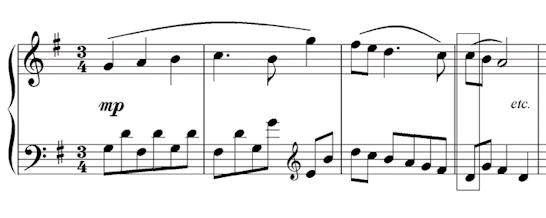In your music theory exam, you might be given a musical score, with questions about finding or naming intervals in that score.
There are a few extra things to keep in mind when you’re looking at a score (as opposed to just an isolated interval).
- Make sure you know which clef is being used.
Often, the clef will be the one which you can see right at the beginning of the piece, but it’s possible, especially in a piano piece, for the clef to change during the piece of music.
In this excerpt for piano, name the interval in the box.

Notice that the left hand starts in the bass clef, but then changes to the treble clef in the 2nd bar, so the lower note in this bracketed interval is actually the D just above middle C. This interval is a minor 7th.
- Watch out for accidentals.
You should always check out the key signature before starting, of course, but you also need to look for accidentals which were written earlier in the bar (or sometime tied into the previous bar), but which still apply.
In this excerpt, the boxed interval has no accidentals of its own, but if you look earlier in the bar, there was a C# in the right-hand which will still apply to this note.

This treble clef note is C# just above middle C, and the bass clef note is the 2nd E below middle C. This is a compound major 6th, or a major 13th.